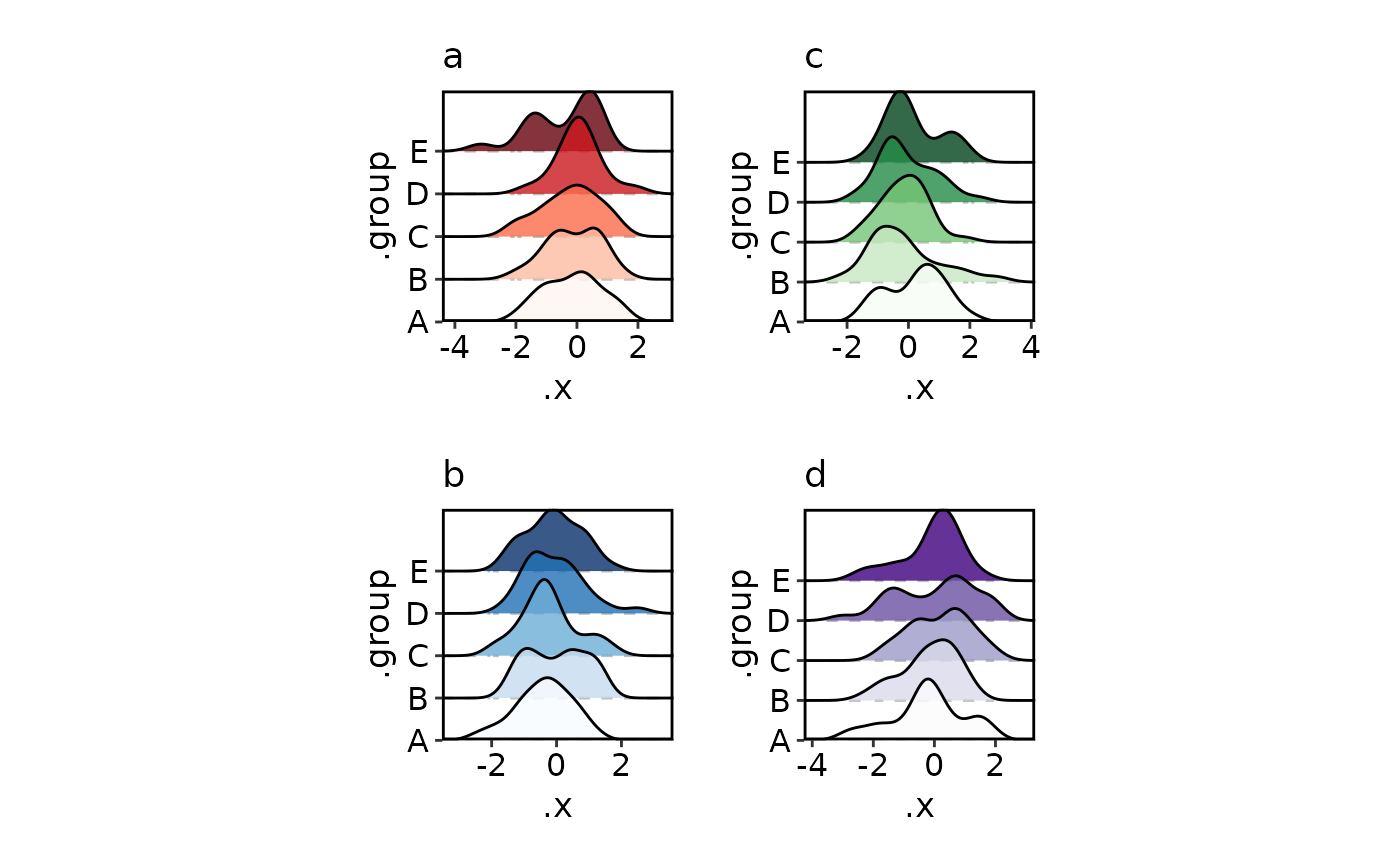Ridge plot to illustrate the distribution of the data in different groups.
Usage
RidgePlot(
data,
x = NULL,
in_form = c("long", "wide"),
split_by = NULL,
split_by_sep = "_",
group_by = NULL,
group_by_sep = "_",
group_name = NULL,
scale = NULL,
add_vline = NULL,
vline_type = "solid",
vline_color = TRUE,
vline_width = 0.5,
vline_alpha = 1,
flip = FALSE,
alpha = 0.8,
theme = "theme_this",
theme_args = list(),
palette = "Paired",
palcolor = NULL,
title = NULL,
subtitle = NULL,
xlab = NULL,
ylab = NULL,
x_text_angle = 90,
keep_empty = FALSE,
reverse = FALSE,
facet_by = NULL,
facet_scales = "fixed",
facet_ncol = NULL,
facet_nrow = NULL,
facet_byrow = TRUE,
aspect.ratio = 1,
legend.position = "none",
legend.direction = "vertical",
combine = TRUE,
nrow = NULL,
ncol = NULL,
byrow = TRUE,
seed = 8525,
axes = NULL,
axis_titles = axes,
guides = NULL,
design = NULL,
...
)Arguments
- data
A data frame.
- x
A character string specifying the column name of the data frame to plot for the x-axis.
- in_form
A character string specifying the form of the data. Default is "long".
- split_by
The column(s) to split data by and plot separately.
- split_by_sep
The separator for multiple split_by columns. See
split_by- group_by
Columns to group the data for plotting For those plotting functions that do not support multiple groups, They will be concatenated into one column, using
group_by_sepas the separator- group_by_sep
The separator for multiple group_by columns. See
group_by- group_name
A character string to name the legend of 'group_by', if 'legend.position' is not "none".
- scale
A numeric value to scale the ridges. See also
geom_density_ridges.- add_vline
A numeric vector or a named list of numeric values to add vertical lines to the plot. If a named list is provided, the names should match the levels of 'group_by'. If
TRUE, the vertical lines will be added at the mean of each group.- vline_type
The type of line to draw for the vertical line.
- vline_color
The color of the vertical line. If
TRUE, the vertical lines will be colored according to the group colors.- vline_width
The width of the vertical line.
- vline_alpha
The alpha value of the vertical line.
- flip
A logical value. If TRUE, the plot will be flipped.
- alpha
A numeric value specifying the transparency of the plot.
- theme
A character string or a theme class (i.e. ggplot2::theme_classic) specifying the theme to use. Default is "theme_this".
- theme_args
A list of arguments to pass to the theme function.
- palette
A character string specifying the palette to use. A named list or vector can be used to specify the palettes for different
split_byvalues.- palcolor
A character string specifying the color to use in the palette. A named list can be used to specify the colors for different
split_byvalues. If some values are missing, the values from the palette will be used (palcolor will be NULL for those values).- title
A character string specifying the title of the plot. A function can be used to generate the title based on the default title. This is useful when split_by is used and the title needs to be dynamic.
- subtitle
A character string specifying the subtitle of the plot.
- xlab
A character string specifying the x-axis label.
- ylab
A character string specifying the y-axis label.
- x_text_angle
A numeric value specifying the angle of the x-axis text.
- keep_empty
A logical value indicating whether to keep empty groups. If FALSE, empty groups will be removed.
- reverse
A logical value. If TRUE, reverse the order of the groups on the y-axis.
- facet_by
A character string specifying the column name of the data frame to facet the plot. Otherwise, the data will be split by
split_byand generate multiple plots and combine them into one usingpatchwork::wrap_plots- facet_scales
Whether to scale the axes of facets. Default is "fixed" Other options are "free", "free_x", "free_y". See
ggplot2::facet_wrap- facet_ncol
A numeric value specifying the number of columns in the facet. When facet_by is a single column and facet_wrap is used.
- facet_nrow
A numeric value specifying the number of rows in the facet. When facet_by is a single column and facet_wrap is used.
- facet_byrow
A logical value indicating whether to fill the plots by row. Default is TRUE.
- aspect.ratio
A numeric value specifying the aspect ratio of the plot.
- legend.position
A character string specifying the position of the legend. if
waiver(), for single groups, the legend will be "none", otherwise "right".- legend.direction
A character string specifying the direction of the legend.
- combine
Whether to combine the plots into one when facet is FALSE. Default is TRUE.
- nrow
A numeric value specifying the number of rows in the facet.
- ncol
A numeric value specifying the number of columns in the facet.
- byrow
A logical value indicating whether to fill the plots by row.
- seed
The random seed to use. Default is 8525.
- axes
A string specifying how axes should be treated. Passed to
patchwork::wrap_plots(). Only relevant whensplit_byis used andcombineis TRUE. Options are:'keep' will retain all axes in individual plots.
'collect' will remove duplicated axes when placed in the same run of rows or columns of the layout.
'collect_x' and 'collect_y' will remove duplicated x-axes in the columns or duplicated y-axes in the rows respectively.
- axis_titles
A string specifying how axis titltes should be treated. Passed to
patchwork::wrap_plots(). Only relevant whensplit_byis used andcombineis TRUE. Options are:'keep' will retain all axis titles in individual plots.
'collect' will remove duplicated titles in one direction and merge titles in the opposite direction.
'collect_x' and 'collect_y' control this for x-axis titles and y-axis titles respectively.
- guides
A string specifying how guides should be treated in the layout. Passed to
patchwork::wrap_plots(). Only relevant whensplit_byis used andcombineis TRUE. Options are:'collect' will collect guides below to the given nesting level, removing duplicates.
'keep' will stop collection at this level and let guides be placed alongside their plot.
'auto' will allow guides to be collected if a upper level tries, but place them alongside the plot if not.
- design
Specification of the location of areas in the layout, passed to
patchwork::wrap_plots(). Only relevant whensplit_byis used andcombineis TRUE. When specified,nrow,ncol, andbyroware ignored. Seepatchwork::wrap_plots()for more details.- ...
Additional arguments.
Value
A ggplot object or wrap_plots object or a list of ggplot objects.
If no split_by is provided, a single plot (ggplot object) will be returned.
If 'combine' is TRUE, a wrap_plots object will be returned.
If 'combine' is FALSE, a list of ggplot objects will be returned.
Examples
set.seed(8525)
data <- data.frame(
x = c(rnorm(250, -1), rnorm(250, 1)),
group = rep(LETTERS[1:5], each = 100)
)
RidgePlot(data, x = "x") # fallback to a density plot
#> Picking joint bandwidth of 0.371
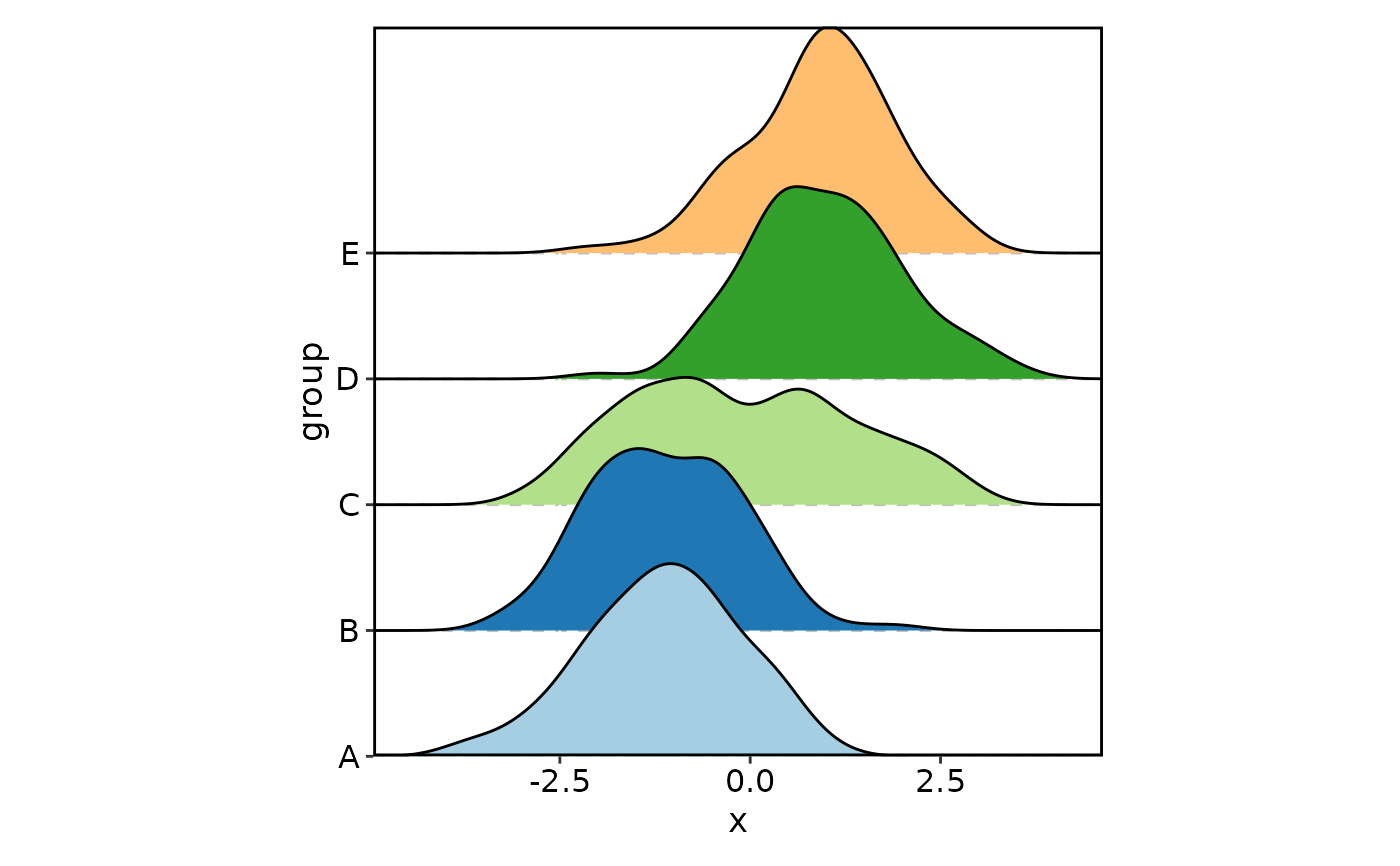 RidgePlot(data, x = "x", add_vline = 0, vline_color = "black")
#> Picking joint bandwidth of 0.371
RidgePlot(data, x = "x", add_vline = 0, vline_color = "black")
#> Picking joint bandwidth of 0.371
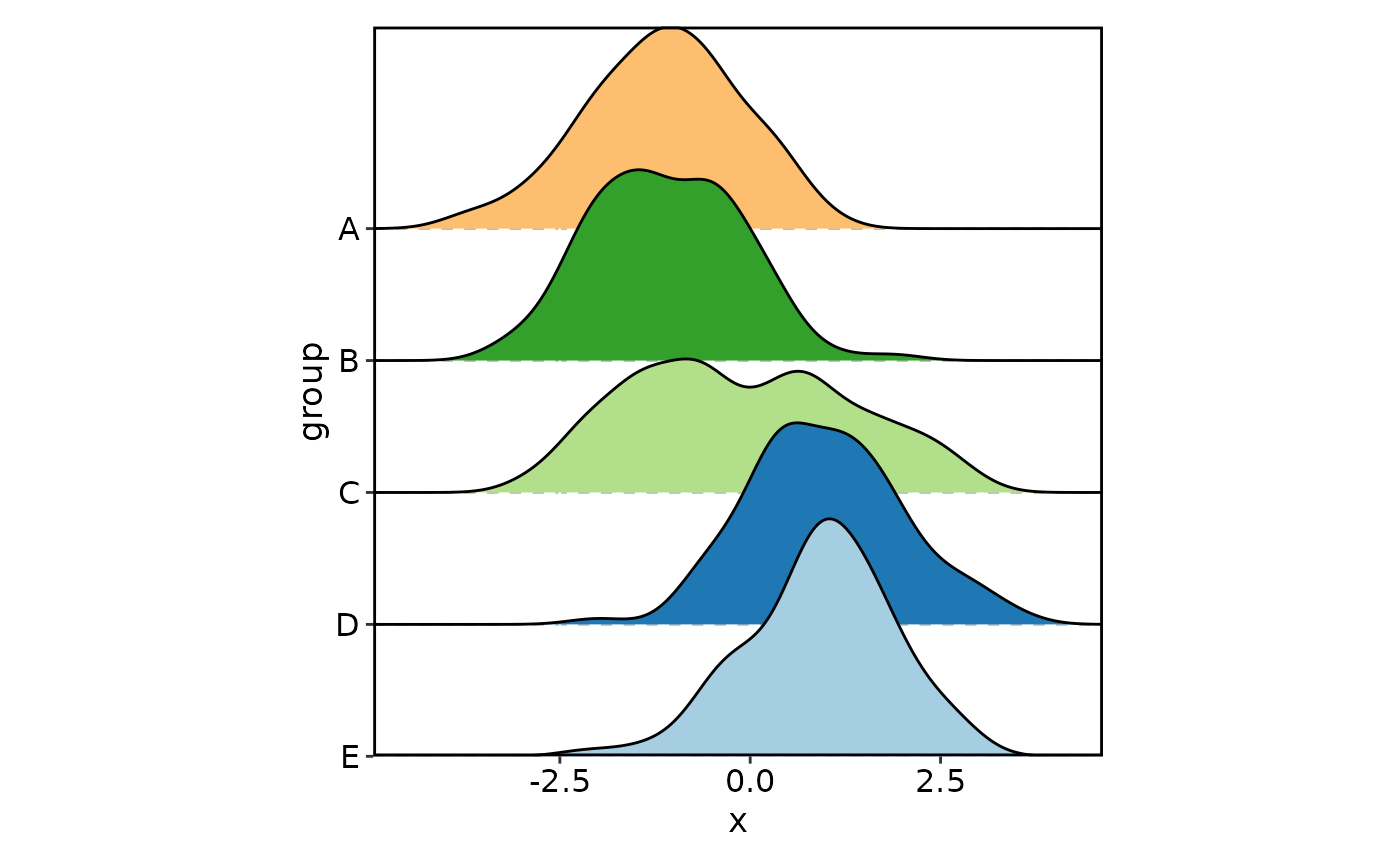 RidgePlot(data, x = "x", group_by = "group")
#> Picking joint bandwidth of 0.378
RidgePlot(data, x = "x", group_by = "group")
#> Picking joint bandwidth of 0.378
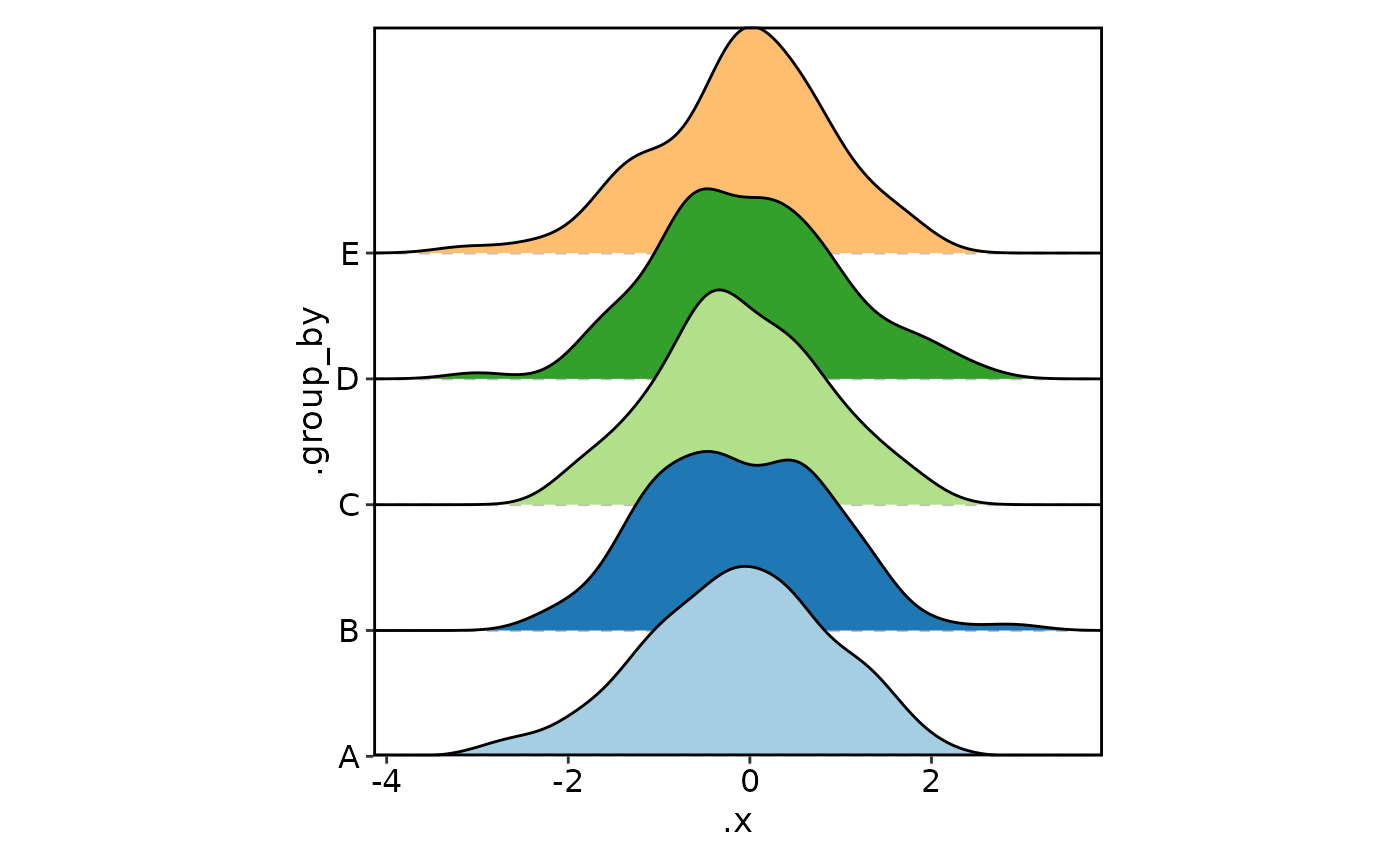 RidgePlot(data, x = "x", group_by = "group", reverse = TRUE)
#> Picking joint bandwidth of 0.378
RidgePlot(data, x = "x", group_by = "group", reverse = TRUE)
#> Picking joint bandwidth of 0.378
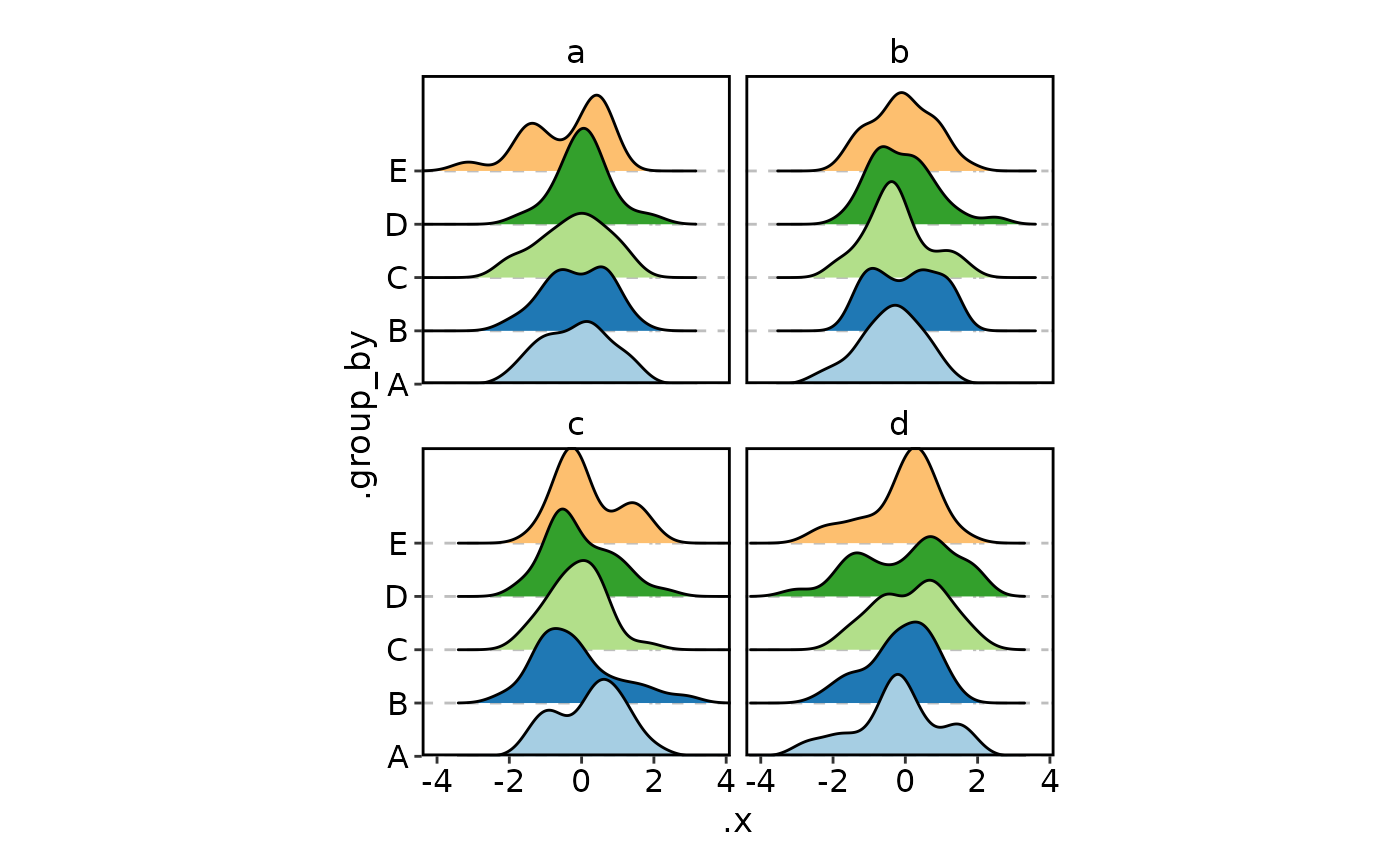 RidgePlot(data, x = "x", group_by = "group",
add_vline = TRUE, vline_color = TRUE, alpha = 0.7)
#> Picking joint bandwidth of 0.378
RidgePlot(data, x = "x", group_by = "group",
add_vline = TRUE, vline_color = TRUE, alpha = 0.7)
#> Picking joint bandwidth of 0.378
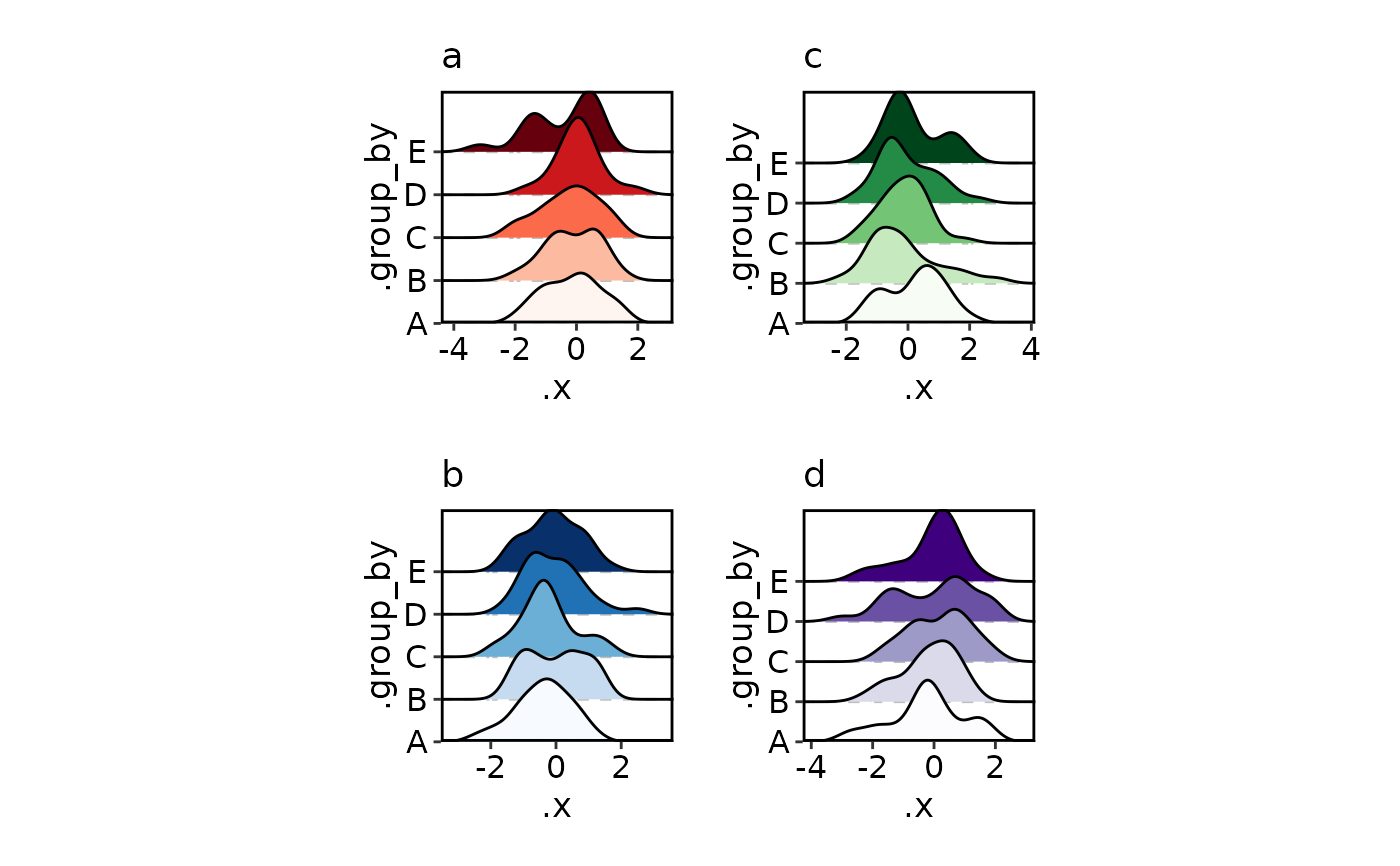 # wide form
data_wide <- data.frame(
A = rnorm(100),
B = rnorm(100),
C = rnorm(100),
D = rnorm(100),
E = rnorm(100),
group = sample(letters[1:4], 100, replace = TRUE)
)
RidgePlot(data_wide, group_by = LETTERS[1:5], in_form = "wide")
#> Picking joint bandwidth of 0.337
# wide form
data_wide <- data.frame(
A = rnorm(100),
B = rnorm(100),
C = rnorm(100),
D = rnorm(100),
E = rnorm(100),
group = sample(letters[1:4], 100, replace = TRUE)
)
RidgePlot(data_wide, group_by = LETTERS[1:5], in_form = "wide")
#> Picking joint bandwidth of 0.337
 RidgePlot(data_wide, group_by = LETTERS[1:5], in_form = "wide", facet_by = "group")
#> Picking joint bandwidth of 0.429
#> Picking joint bandwidth of 0.367
#> Picking joint bandwidth of 0.416
#> Picking joint bandwidth of 0.428
#> Picking joint bandwidth of 0.429
#> Picking joint bandwidth of 0.367
#> Picking joint bandwidth of 0.416
#> Picking joint bandwidth of 0.428
RidgePlot(data_wide, group_by = LETTERS[1:5], in_form = "wide", facet_by = "group")
#> Picking joint bandwidth of 0.429
#> Picking joint bandwidth of 0.367
#> Picking joint bandwidth of 0.416
#> Picking joint bandwidth of 0.428
#> Picking joint bandwidth of 0.429
#> Picking joint bandwidth of 0.367
#> Picking joint bandwidth of 0.416
#> Picking joint bandwidth of 0.428
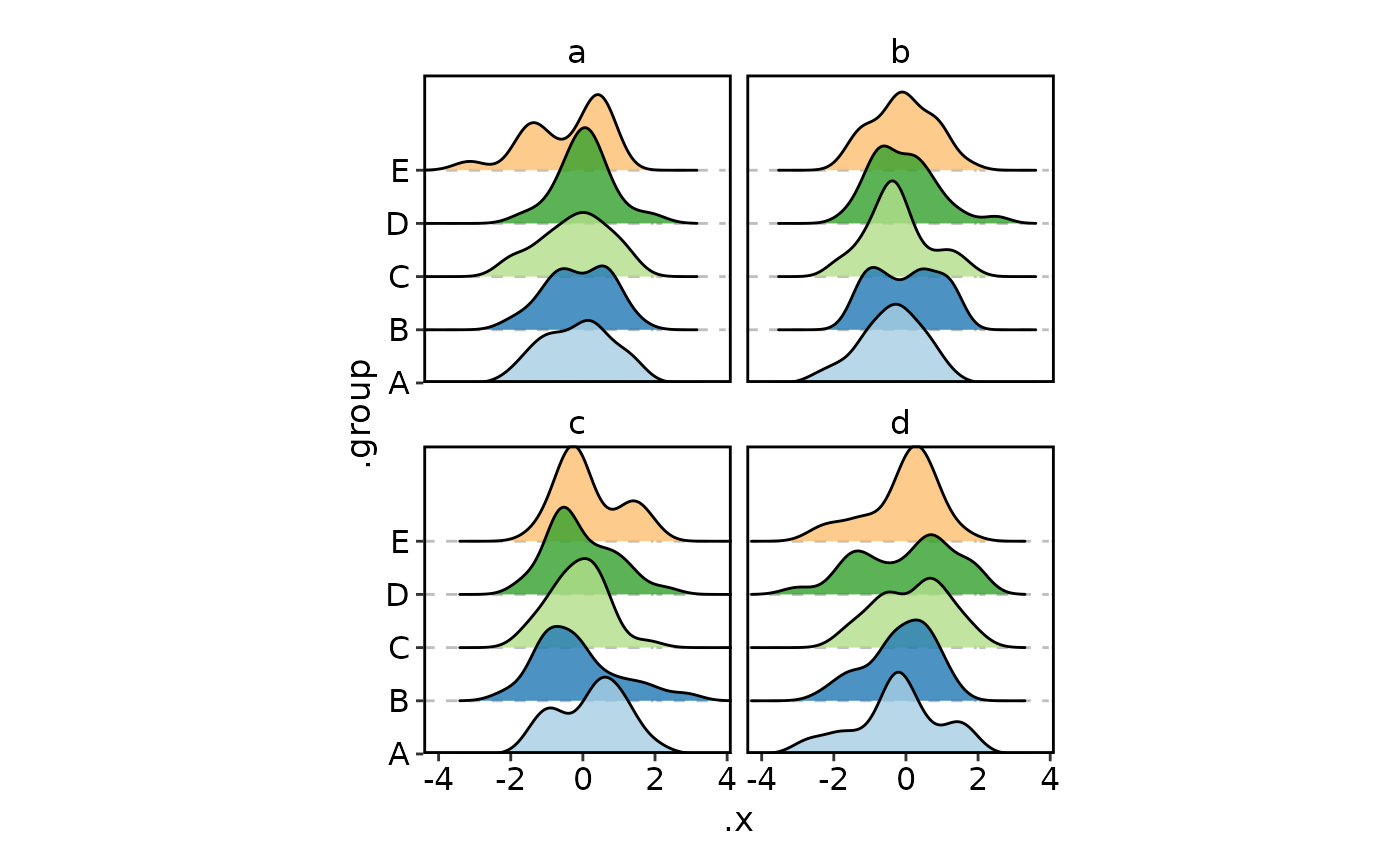 RidgePlot(data_wide, group_by = LETTERS[1:5], in_form = "wide", split_by = "group",
palette = list(a = "Reds", b = "Blues", c = "Greens", d = "Purples"))
#> Picking joint bandwidth of 0.429
#> Picking joint bandwidth of 0.416
#> Picking joint bandwidth of 0.367
#> Picking joint bandwidth of 0.428
RidgePlot(data_wide, group_by = LETTERS[1:5], in_form = "wide", split_by = "group",
palette = list(a = "Reds", b = "Blues", c = "Greens", d = "Purples"))
#> Picking joint bandwidth of 0.429
#> Picking joint bandwidth of 0.416
#> Picking joint bandwidth of 0.367
#> Picking joint bandwidth of 0.428
